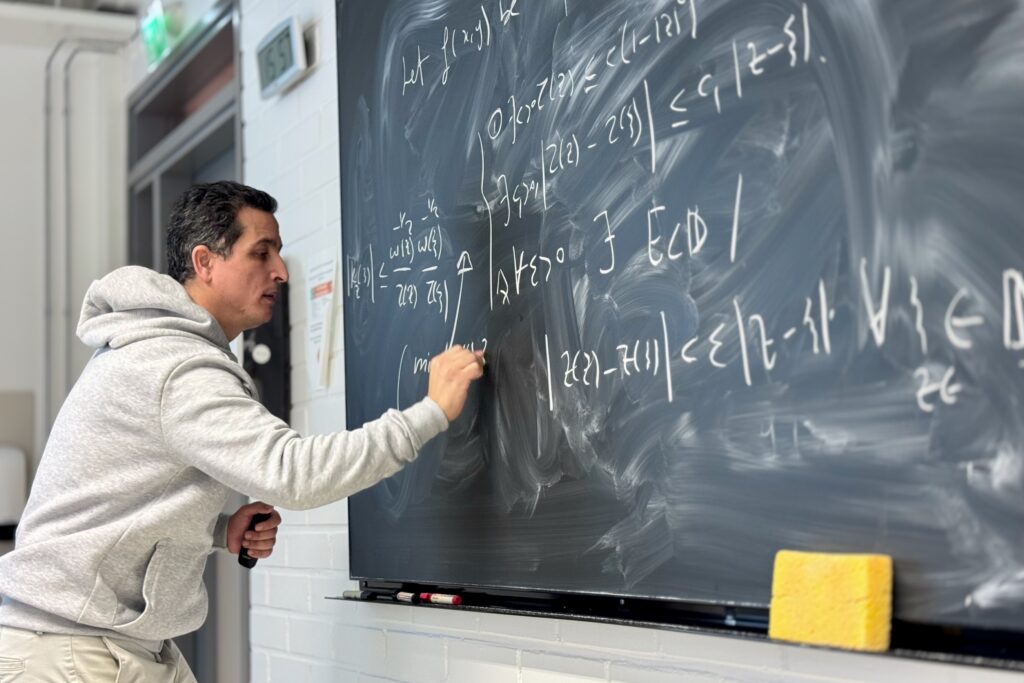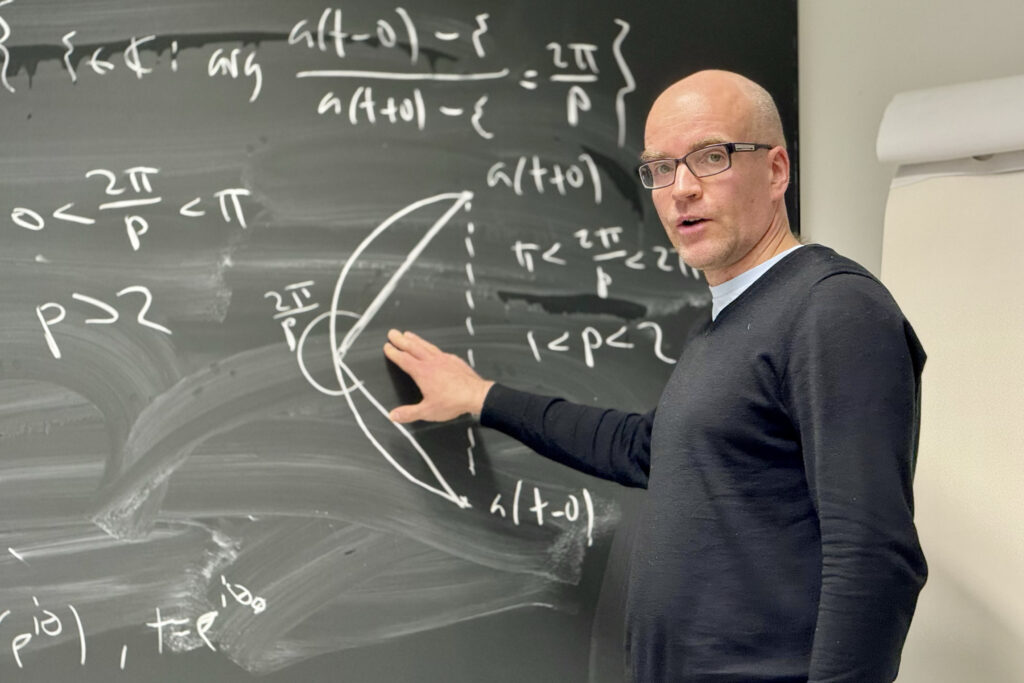Tuesday, May 6, 2025 2:15 to 3:00 PM in M303
Atte Pennanen, University of Eastern Finland
Carleson measures for Bergman-Zygmund spaces induced by doubling weights
We consider generalized weighted Bergman-Zygmund spaces induced by doubling weights and generalized Lebesgue-Zygmund spaces induced by positive Borel measures. We begin by showing some basic properties of a certain class of inducing functions and doubling weights. We then characterize the boundedness and compactness of the identity operator from weighted Bergman-Zygmund spaces to Lebesgue-Zygmund spaces. Talk is based on joint work with H. R. Cho, H. Koo, Y. J. Lee, J. Rättyä and F. Wu.
Tuesday, April 29, 2025, 2:15 to 3:00 PM in M301
Amine Zemirni, National Higher School of Mathematics, Algeria
On Some Problems of Complex ODEs
A classical question in the theory of complex ordinary differential equations (ODEs) is to determine the properties of solutions based on the behavior of the coefficients. Typically, some strong assumptions are imposed on the coefficients to obtain meaningful results. In this talk, we explore ways to relax some of these assumptions by considering cases where some coefficients themselves satisfy linear ODEs.
Several situations will be discussed in this talk, involving both linear and nonlinear equations, along with related problems. A central focus will be on Tumura–Clunie-type equations of the form f^n+P(z,f)=h, where P(z,f) is a differential polynomial with small-function coefficients, and h is a meromorphic function satisfying a linear differential equation with rational coefficients. These investigations on Tumura-clunie equations lead to new insights into the distribution of zeros and critical points of solutions to certain linear ODEs.
Finally, we will discuss Bruck’s conjecture for solutions of linear ODEs, with emphasis on the case where the hyper-order of the solution >1.
Tuesday, April 8, 2025, 2:15 to 3:00 PM in M303
Changyu Guo, University of Eastern Finland
Geometric characterization of Gromov hyperbolicity in Euclidean spaces and beyond
In the fundamental work of Bonk-Heinonen-Koskela [Astérisque 2001], the authors extended the classical uniformization theory for simply connected planar domains to a large class of locally compact metric spaces. The key new ingredients include the theory of Gromov hyperbolic spaces, introduced by M. Gromov in his celebrated work in 1987, a version of Gehring-Hayman inequality in metric spaces, and the theory of quasiconformal maps developed by Heinonen-Koskela in [Acta Math. 1998]. They also asked a few fundamental open problems related to Gromov hyperbolicity.
In this talk, I will report a series of our recent works related to these open problems. In particular, we develop a completely new approach to establish the dimension-free Gehring-Hayman inequality in general Banach spaces and based on this, we establish a characterization of Gromov hyperbolicity and inner uniformity in general Banach spaces. These solve some open problems asked by Heinonen and Vaisala in the 1990s and early 2000s. Futhremore, we develop a new approach to establish an optimal geometric characterization of Gromov hyperbolicity in general Euclidean spaces and Q-regular length spaces, which solve some long-standing open problems asked by Bonk-Heinonen-Koskela [Astérisque 2001], Balogh-Buckley [Invent. Math. 2003] and Koskela-Lammi-Manojlović [Ann. Sci. Éc. Norm. Supér. 2014].
Tuesday, March 18, 2025, 2:15 to 3:00 PM in M305
Fanglei Wu, University of Eastern Finland
Composition semigroups on spaces of analytic functions in the unit disc
In this talk, I am going to show some popular research topics related to composition semigroups, which mainly include the following problems: 1. When are composition semigroups strongly continuous? 2. If composition semigroups are strongly continuous, then what properties do they have? How to depict the spectra of their infinitesimal generators? 3. How to use composition semigroups to deal with other problems? I will also present some unsolved questions.
Thursday, March 6, 2025, 4:15 PM
Finnish Mathematical Society Colloquium

Haakan Hedenmalm, KTH, Sweden
Conformally invariant Gaussian analytic functions, holomorphic correlations, and operator symbols of contractions
Monday, February 17, 2025, 3:15 to 4:00 PM in M304

Hicham Arroussi, University of Helsinki, Finland
Embedding theorems and generalized weighted composition operators on large Bergman spaces
We characterize boundedness, compactness and Schatten class membership of the generalized weighted composition operator between exponentially weighted Bergman spaces. We also obtain estimates for the norm of the derivatives of the corresponding reproducing kernel and describe bounded and compact differentiation operators, which generalize the embedding theorems of Luecking and the criteria for bounded and compact Carleson measures. Joint work with J. Taskinen and J. Virtanen.
Friday, February 7, 2025, 2:15 to 3:00 PM in M106

Santeri Miihkinen, University of Reading, UK
Toeplitz operators with piecewise continuous symbols on Hardy spaces
We consider Toeplitz operators acting on the Hardy spaces Hp for 1 ≤ p < ∞. Geometric descriptions of the essential spectra of Toeplitz operators up to piecewise continuous symbols are well known for 1 < p < ∞. We will investigate what happens in the case p = 1. The talk is based on joint work with J. Virtanen.
Friday, January 24, 2025, 2:15 to 3:00 PM in M107

David Norrbo, University of Reading, UK
Norm, essential norm and maximal sequences on certain classes of Banach spaces
Let X be a separable reflexive space with two additional properties, the compact approximation property and (m_p). This class of spaces is a generalization of l^p spaces. Two interesting questions are: for which operators are the norm and the essential norm equal? And which operators are norm-attaining? It turns out that these questions can be answered based on the minimal and maximal weak cluster points of the operators’ maximizing sequences. As a consequence, a non-standard formula for the essential norm is obtained.

